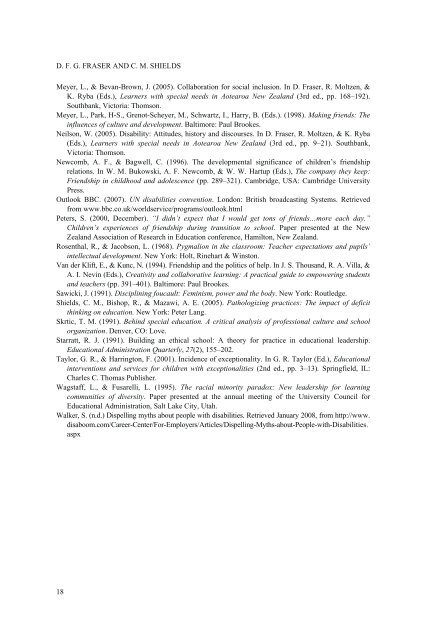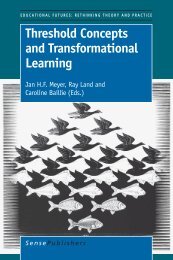Leadership for Inclusion
577-leadership-for-inclusion
577-leadership-for-inclusion
- No tags were found...
Create successful ePaper yourself
Turn your PDF publications into a flip-book with our unique Google optimized e-Paper software.
D. F. G. FRASER AND C. M. SHIELDS<br />
Meyer, L., & Bevan-Brown, J. (2005). Collaboration <strong>for</strong> social inclusion. In D. Fraser, R. Moltzen, &<br />
K. Ryba (Eds.), Learners with special needs in Aotearoa New Zealand (3rd ed., pp. 168–192).<br />
Southbank, Victoria: Thomson.<br />
Meyer, L., Park, H-S., Grenot-Scheyer, M., Schwartz, I., Harry, B. (Eds.). (1998). Making friends: The<br />
influences of culture and development. Baltimore: Paul Brookes.<br />
Neilson, W. (2005). Disability: Attitudes, history and discourses. In D. Fraser, R. Moltzen, & K. Ryba<br />
(Eds.), Learners with special needs in Aotearoa New Zealand (3rd ed., pp. 9–21). Southbank,<br />
Victoria: Thomson.<br />
Newcomb, A. F., & Bagwell, C. (1996). The developmental significance of children’s friendship<br />
relations. In W. M. Bukowski, A. F. Newcomb, & W. W. Hartup (Eds.), The company they keep:<br />
Friendship in childhood and adolescence (pp. 289–321). Cambridge, USA: Cambridge University<br />
Press.<br />
Outlook BBC. (2007). UN disabilities convention. London: British broadcasting Systems. Retrieved<br />
from www.bbc.co.uk/worldservice/programs/outlook.html<br />
Peters, S. (2000, December). “I didn’t expect that I would get tons of friends…more each day.”<br />
Children’s experiences of friendship during transition to school. Paper presented at the New<br />
Zealand Association of Research in Education conference, Hamilton, New Zealand.<br />
Rosenthal, R., & Jacobson, L. (1968). Pygmalion in the classroom: Teacher expectations and pupils’<br />
intellectual development. New York: Holt, Rinehart & Winston.<br />
Van der Klift, E., & Kunc, N. (1994). Friendship and the politics of help. In J. S. Thousand, R. A. Villa, &<br />
A. I. Nevin (Eds.), Creativity and collaborative learning: A practical guide to empowering students<br />
and teachers (pp. 391–401). Baltimore: Paul Brookes.<br />
Sawicki, J. (1991). Disciplining foucault: Feminism, power and the body. New York: Routledge.<br />
Shields, C. M., Bishop, R., & Mazawi, A. E. (2005). Pathologizing practices: The impact of deficit<br />
thinking on education. New York: Peter Lang.<br />
Skrtic, T. M. (1991). Behind special education. A critical analysis of professional culture and school<br />
organization. Denver, CO: Love.<br />
Starratt, R. J. (1991). Building an ethical school: A theory <strong>for</strong> practice in educational leadership.<br />
Educational Administration Quarterly, 27(2), 155–202.<br />
Taylor, G. R., & Harrington, F. (2001). Incidence of exceptionality. In G. R. Taylor (Ed.), Educational<br />
interventions and services <strong>for</strong> children with exceptionalities (2nd ed., pp. 3–13). Springfield, IL:<br />
Charles C. Thomas Publisher.<br />
Wagstaff, L., & Fusarelli, L. (1995). The racial minority paradox: New leadership <strong>for</strong> learning<br />
communities of diversity. Paper presented at the annual meeting of the University Council <strong>for</strong><br />
Educational Administration, Salt Lake City, Utah.<br />
Walker, S. (n.d.) Dispelling myths about people with disabilities. Retrieved January 2008, from http://www.<br />
disaboom.com/Career-Center/For-Employers/Articles/Dispelling-Myths-about-People-with-Disabilities.<br />
aspx<br />
18




